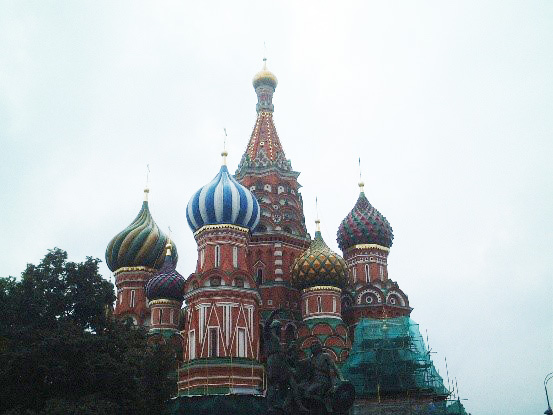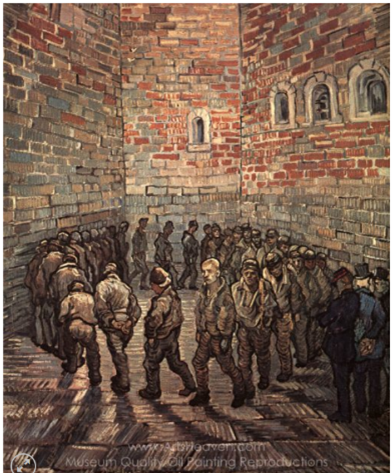31 Jul From Khabarovsk to St Petersburg on the Trans-Siberian Railway Part 3 of 4
[Continued from Part 2]
Moscow
Moscow, K0. Day 8. Having arranged to meet Ulrich for lunch the following day I set out for a police station to have my visa registered. Once I realised it was an ‘out of town’ station I had my guide call his boss who sensibly instructed him to take me to my homestay first. It took over two hours, possibly because the trip took us over a bridge into Red Square and back again. Olga’s apartment was not far from Moscow’s ‘Arc de Triomphe’ off a boulevard serving as a race track out of town for all the big BMW’s that have been stolen in Germany according to Ulrich (all except the one hijacked from Chris Curtis on the Périphérique). Olga is overendowed in the backside department but speaks English reasonably well even if she doesn’t understand much. My room is comfortable and there is a new shower enclosure which is an improvement on Khabarovsk and Irkutsk.
I Went out to find an ATM and ended up walking all the way down to the bridge over the Moskva River then back for dinner AT Pinocchio, an Italian restaurant on Kutuzovsky Avenue. It was a good restaurant. Afterwards it was pouring, so I got a taxi home with the help of the young restaurant manager who spoke English was understood it as well. He told me that at 10 am it takes him two hours to drive to work and at 11 pm it takes him 20 minutes to drive home.
Day 9, 3 September 2004. After Olga’s omelette I took the underground to Ploshchad Revolyutsii, the amazing station just a short walk from Red Square renowned for its grand Stalinist architecture. Opened in 1938, the station features marble-clad walls, vaulted ceilings and bronze sculptures of model Soviet citizens – soldiers, farmers and athletes, nestled in niches between the arches.
The rain wasn’t giving up so I bought a cheap umbrella. It barely worked and I was happy to abandon it in the Hermitage cloakroom three days later. I retreated to the vast shopping mall on the eastern side of Red Square. GUM is a department store an iconic nineteenth century building with a stunning glass roof housing what might be the largest collection of luxury brand tat in the world. On the brighter side the rents preserve an architectural masterpiece that does credit to its place on Red Square.
As I walked down to the Rossiya Hotel for my rendezvous with Ulrich, I took a photograph of St Basil’s. It was framed by dark clouds so didn’t look its best. Ulrich was in the foyer checking out as I arrived. He was keen to have lunch in the State Historical Museum, so that’s where we went. After ten days in Russia, I had to order my first blini. It was topped with sour cream and yes, vodka on the side. A hardboiled egg with mayonnaise on the side would have been better. The conversation turned to neurosurgery. The prospect of returning to work was preying on Ulrich’s mind. Most head injuries in Karlsruhe were sustained by falling drunks and if the remedial surgery failed, as was often the case, it was his job to inform the family.

He was also deeply concerned with the progress of stem cell technology, which he felt would lead to a master race for the rich. Fortunately, his worst fears haven’t materialised. Stem cell science has advanced significantly over the past two decades, particularly with the development of induced pluripotent stem cells, but organ and brain regeneration remain largely experimental. Fears of a ‘master race’ have not eventuated, as human germline editing is banned or tightly regulated in most countries. However, access to cutting-edge therapies is highly unequal, with wealthier individuals benefiting first. In neuroscience, stem cell-based cures for major conditions like Alzheimer’s or spinal injuries are still in early stages. Ethical overseeing and international regulation have largely contained the most extreme or dystopian uses of the technology.
Ulrich had to rush to the station after lunch. I toured the museum. I was interested to see that some of Mochanov’s Yakutsk artefacts were on exhibition, with the underlying message challenging Western orthodoxy and highlighting Russia’s deep prehistory, particularly in the vast, little-studied regions of Siberia.
Midafternoon there was a break in the rain, so I found an Internet cafe where I was able to read the latest news and understand why Mum has been nagging me to get on the next plane out of Russia. Details of the Beslan School siege were emerging. Two days earlier, on the first day of school, 32 heavily armed Chechen and Ingush militants, affiliated with the separatist movement in Chechnya, stormed School No. 1 in Beslan, North Ossetia, taking over 1,100 hostages, mostly children. After a tense three-day siege, explosions and a chaotic rescue left 334 dead, including 186 children. The tragedy shocked Russia, exposed security failures, and cast a long shadow over the Caucasus.
Clearly nothing had been learnt from the 2002 Dubrovka Theatre hostage crisis. In that incident, Chechen militants seized Moscow’s Dubrovka Theatre during a performance of the musical Nord-Ost, taking 912 hostages. After three days, Russian special forces ended the siege by releasing an undisclosed gas into the building before storming it. All forty attackers were killed along with at least 130 hostages, mostly from the effects of the gas, sparking criticism over the secrecy and handling of the rescue. But they don’t care. Putin doesn’t care. Ninety thousand Russian soldiers have been killed in Ukraine and the only thing Putin regrets is that he will have to find uniforms for the next ninety thousand.
On the way back to Ploshchad Revolyutsii I decided to wander over to what looked like an Opera House. It was the Bolshoi theatre. And shortly there was to be a performance, although you would never know since the main entrance was closed. Thanks to Chechen separatists the entrance was via a side door through metal detectors and a pack of menacing dogs. Surrounded by babbling touts, I bought a fifth tier balcony seat ticket for 500 roubles. It turned out to be a performance of Prokofiev’s The Fiery Angel, a dark psychothriller that tells the story of a Renata obsessed with a fiery angel she believes is guiding her to spiritual purity. When the angel disappears she is convinced it has taken human form in Count Heinrich who rejects her, possibly because she is off her rocker. Desperate and tormented, she turns to the knight Ruprecht, who becomes infatuated with her. Renata’s descent into madness deepens as she dabbles in the occult and confronts visions of demonic possession. It all ends with Renata condemned by the Inquisition, while Ruprecht, powerless to save her, watches her consumed by her own delusions.
My fifth-tier balcony seat was not for the dizzy or faint hearted but afforded a panoramic view of a brilliant set and at times frenetic action. I had never even heard of the opera but it was a performance that has stuck with me like the Komische Opera’s Figaro. A red dress on a red floor what a set! Excellent direction great orchestra. Russia has been worthwhile despite the cruelty. I found my way home on the tube.
The next morning was bright and sunny, so I headed for the Pushkin State Museum of Fine Arts. I had spent an hour or more on the ground floor viewing exhibits I was not really interested in before discovering an eye-watering collection of Monet, Degas, Renoir, van Gogh, Gauguin, and Cézanne upstairs. While some of these masterpieces will certainly be contested cultural property, seized during WWII, one Van Gough in the Pushkin is undoubtedly at home in Russia regardless of who owns it.
It was about 4:00 PM when I finished at the Pushkin. The sun was out and I thought it would be nice to wander through Red Square. It was closed – more terrorists no doubt. What a mess! I found another internet cafe and read about Australia’s looming federal election. Al Gore’s film, An Inconvenient Truth wouldn’t be released for another two years so it was an age before ‘climate change’ and John Howard eventually won the election in a trot.

My favourite hotel is the Metropole in Hanoi. Grahame Greene was well known in its cocktail bar and if you have ever had a cocktail there you will know why. So, I was keen to try one in Moscow’s ‘Metropol’ which is next door to the Bolshoi Theatre. Its cocktail bar was named after the renowned Russian bass Fyodor Chaliapin whose signature role was Boris Godunov and whose favourite tipple was Georgian red wine. That must have amused the barman.
Like its sister hotel in Hanoi, the Moscow Metropol epitomises style. The exterior façade is a blend of Art Nouveau and Neo-Russian with decorative flourishes from the Russian romantic and European fin-de-siècle periods. But there is no need to describe the Moscow Metropol here because its done brilliantly in Amor Towles’s A Gentleman in Moscow, the best contemporary novel I have read since Wolf Hall.
Set in 1922 Russia, the novel follows Count Alexander Ilyich Rostov, an aristocrat who is sentenced by a Bolshevik tribunal to house arrest in Moscow’s Hotel Metropol. He must live out his days in a small attic room of the grand hotel, never setting foot outside, under threat of execution. Despite this confinement, the Count maintains his elegance, dignity, and wit. Over the decades, he builds a rich inner life, forms deep friendships with hotel staff and guests and navigates the sweeping changes of Soviet history from his vantage point inside the hotel.
There wasn’t much conversation to be had in the bar in the early evening so I sipped my vodka martini (despite my vows never to drink it again) and headed back to Ploshchad Revolyutsii and Olgas for forty winks before taking a taxi to the station for the midnight express to St Petersburg which arrived there at 8 am.




No Comments